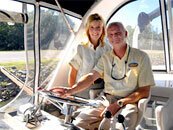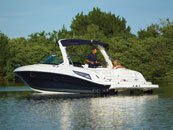By Wayne Spivak
Branch Chief - Training Department
United States Coast Guard Auxiliary
Many of you have read the obligatory "how to winterize your boat," followed by the "getting ready for season" article. While each of these articles is important, there something that every boat owner can be doing during the down time you experience between those two articles.
Think Boating Safety!
There is no time like the present to examine last year, and plan for next. Maybe you just sold your boat, or are in the process. What type of boat and boating are you now looking forward to? How does this impact on the safety of you and your passengers? Are you in need of more boating education? Do you have enough experience (piloting) in the class of boat that you are purchasing?
Maybe you’re keeping your boat for next season, but found you had some difficulties maneuvering her, or confusion as to the buoys and how to read them. Again, additional boating education may solve this dilemma.
In either case, you are going to need to either check (and now it a good time to do this chore) and see if your safety equipment is current or what type of equipment you may need to purchase.
Here’s a list of removable or portable safety equipment (and I’m taking a very broad view on the word safety) and why you may want to check them. While not all inclusive, it should cover the majority of the equipment you have, whether federally or state mandated or just plain old common sense items:
Anchor’s and anchor rodes - corrode and fray; batteries - discharge and need servicing; charts and other reference and or navigational material - need updating; coolers - mildew, crack and need cleaning and replacement; emergency rafts - need servicing; fire extinguishers - discharge; first aid kits and other personal hygiene items- need replenishment; flares and other pyrotechnics - expire; foul weather gear, and harnesses - mildew, corrode and need repair; lines - chafe and fray; LP - corrodes and needs replenishment; PFD’s - disintegrate, discharge and corrode; PIW kits - corrode, disintegrate and need repair; play toys, such as floats, ski’s, rafts, etc - need cleaning, repair and replacing; radio’s, EPIRB’s and other electronics - corrode and batteries die; rags, towels and other protective clothing - need cleaning and replacing; sound producing devices - corrode and need replenishment; tool kit - corrode and need servicing; weather forecasting equipment - needs cleaning, repair and adjusting.
Wow, now that can be a lot of gear! But if you use your time expeditiously, it isn’t an insurmountable task. Remember, the last items you wish to replace are those that have an expiration date - such as flares, and other pyrotechnics and first aid supplies. You might as well buy them with the latest manufacture date as possible, since pyrotechnics have a three (3) year life, and first aid supplies have limited life spans as well. Get your monies worth! And, don’t throw away those just-expiring flares (however, you should throw away expired first aid supplies).
Think Safety - Three flares (a federal requirement) are just not enough should you ever happen to really need to use them! While the flares expire in three years, their useful lives are much longer. Arrange your flares so that the oldest flare is the first one you use. If it doesn’t work, you then can take the next newer one. Remember, just because a flare is within the expiration time (just manufactured), doesn’t mean that it will work!
Many people go out and buy the smallest commercial first aid kits. While these may be just fine for simple problems; on a boat, they just don’t cover all the possible injuries. Supplement your first aid kit to reflect the type of boating and activities you do on your boat. For an example, you fish on your boat. What can go wrong? Ever get a fish hook impaled in a finger or other part of your body? Your standard first aid kit won’t help here.
The Massachusetts Medical Society suggests that if this happens it "…can usually be removed without the aid of a doctor. Do Not slide the hook up through the skin, cut off the barb, and pull the fish hook back out in reverse. Instead, Loop a string around the curve of the hook and grasp the string with one hand. With the other hand, gently press down on the hook’s shaft to free the barb from surrounding tissue. Once the barb is disengaged, yank quickly on the string to pull the hook from the wound."
Scott H Plantz, MD, FAAEM, Research Director, Assistant Professor, Department of Emergency Medicine, Mount Sinai School of Medicine suggests this procedure: Using "…pliers, forceps to push the hook gently through the skin, following the curve of the hook. Cut off the barb so that the un-barbed portion can be backed out. Do not close the wound." To prevent tetanus and other infections, get medical attention as soon as possible."
Does your first aid kit have a string or pliers or forceps?
Think Safety - not only should you take boating education, but you should also take a first aid course (contact your local Red Cross chapter for a course near you!)
Some of you looked at our list and said, gee, coolers and tool kits are safety items? If you take a second, you’ll see that safety is a very very broad topic. Coolers hold your food. If your coolers are dirty and full of mold and mildew, it breeds the possibility of disease. What good is a nice day on the boat if you get food poisoning or have other allergic reactions?
Think Safety - Cleanliness is an important part of keeping healthy, and mildew, mold, and dirt isn’t healthy.
Your tool kit can make a day out on the water a pleasant one or a long and treacherous one. Should your engine or some other electronic device die, and you don’t have tools that are a) the right type needed and b) workable, then you might wait a very long time before commercial help arrives.
Think Safety - not only should you maintain your tools, but maybe a small engine repair course given at your local BOCES or high school wouldn’t be such a bad idea! Many of the common engine problems (clogged filters, fouled plugs and points) you may encounter on the water can be fixed if you have a basic understanding of small engine repair.
Your boat lives in the water. All the equipment on your boat is exposed to the water on a daily basis, during the entire boating season. In salt water environments, the corrosive effect is even greater, but there is a corrosive effect for fresh water boaters - don’t be lulled into a false sense of security.
Since corrosion occurs on metal parts, and most of the safety equipment contains some metal, take the time to clean and repair and replace metal parts that may not hold up under next years use. Not only does water corrode, but the sun and heat also takes its toll on equipment. PFD’s do not last forever. Check them and make sure the kapock (the floatation material used in many PFD’s) is firm and hard to the touch. If it feels like the kapock has broken down, and is no longer firm, replace the PFD. A PFD that won’t provide the needed buoyancy is no longer a flotation device.
Think Safety - Check and replace your PFD’s every season. Make sure you carry the appropriate PFD’s for your boating styles. If you go out in the ocean, purchase TYPE I PFD’s. If your near-shore or in the bays, rivers, etc, then a TYPE II or TYPE III may be a better choice (and cheaper in many instances).
Think Safety - a PFD locked away in a hold, underneath a ton of other items is not only a violation of federal law, but more importantly USELESS. A PFD that is not worn, while underway increases your chances of drowning should an accident befall your craft, since you’ll need to take extra time, in an emergency to locate and don the PFD. Wear your PFD at all times!
Think Safety - while your boating season is in a lull or just beginning to start-up again, take a cold hard objective view of your boat, boating locations, boating habits and boating equipment.
Service your equipment, making sure it’s in the best possible shape for the next boating season and that the equipment matches the type of boat and boating habits you intend on using. Take some courses. First Aid courses, small engine repair, safe boating and navigation courses can make this great sport of ours not only more fun, but safer for you, your familes, your passengers and the other boaters that you encounter.
For more information about United States Coast Guard Auxiliary safe boating courses, contact your local Flotilla via either your local Coast Guard unit or on the web at www.cgaux.org. The Coast Guard can be found in your yellow pages or on the web at www.uscg.mil.
The Coast Guard Auxiliary is made up of approximately 35,000 men and women, who each donate hundreds of hours each year in support of the Coast Guard and its mission. Should you wish to donate your time, please contact your local Flotilla or Coast Guard unit.

